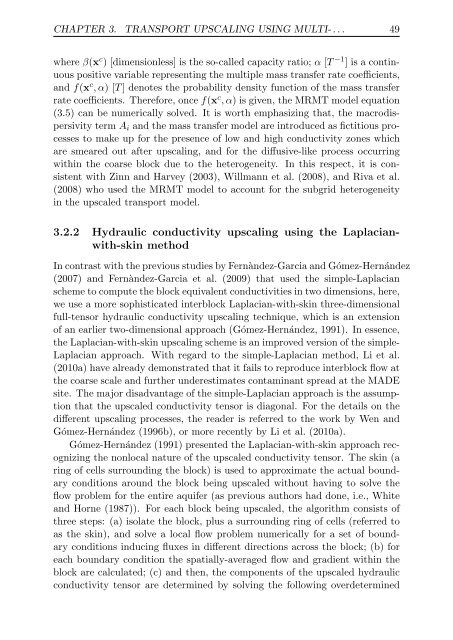Upscaling and Inverse Modeling of Groundwater Flow and Mass ...
Upscaling and Inverse Modeling of Groundwater Flow and Mass ...
Upscaling and Inverse Modeling of Groundwater Flow and Mass ...
Create successful ePaper yourself
Turn your PDF publications into a flip-book with our unique Google optimized e-Paper software.
CHAPTER 3. TRANSPORT UPSCALING USING MULTI- . . . 49<br />
where β(x c ) [dimensionless] is the so-called capacity ratio; α [T −1 ] is a continuous<br />
positive variable representing the multiple mass transfer rate coefficients,<br />
<strong>and</strong> f(x c , α) [T ] denotes the probability density function <strong>of</strong> the mass transfer<br />
rate coefficients. Therefore, once f(x c , α) is given, the MRMT model equation<br />
(3.5) can be numerically solved. It is worth emphasizing that, the macrodispersivity<br />
term Ai <strong>and</strong> the mass transfer model are introduced as fictitious processes<br />
to make up for the presence <strong>of</strong> low <strong>and</strong> high conductivity zones which<br />
are smeared out after upscaling, <strong>and</strong> for the diffusive-like process occurring<br />
within the coarse block due to the heterogeneity. In this respect, it is consistent<br />
with Zinn <strong>and</strong> Harvey (2003), Willmann et al. (2008), <strong>and</strong> Riva et al.<br />
(2008) who used the MRMT model to account for the subgrid heterogeneity<br />
in the upscaled transport model.<br />
3.2.2 Hydraulic conductivity upscaling using the Laplacianwith-skin<br />
method<br />
In contrast with the previous studies by Fernàndez-Garcia <strong>and</strong> Gómez-Hernández<br />
(2007) <strong>and</strong> Fernàndez-Garcia et al. (2009) that used the simple-Laplacian<br />
scheme to compute the block equivalent conductivities in two dimensions, here,<br />
we use a more sophisticated interblock Laplacian-with-skin three-dimensional<br />
full-tensor hydraulic conductivity upscaling technique, which is an extension<br />
<strong>of</strong> an earlier two-dimensional approach (Gómez-Hernández, 1991). In essence,<br />
the Laplacian-with-skin upscaling scheme is an improved version <strong>of</strong> the simple-<br />
Laplacian approach. With regard to the simple-Laplacian method, Li et al.<br />
(2010a) have already demonstrated that it fails to reproduce interblock flow at<br />
the coarse scale <strong>and</strong> further underestimates contaminant spread at the MADE<br />
site. The major disadvantage <strong>of</strong> the simple-Laplacian approach is the assumption<br />
that the upscaled conductivity tensor is diagonal. For the details on the<br />
different upscaling processes, the reader is referred to the work by Wen <strong>and</strong><br />
Gómez-Hernández (1996b), or more recently by Li et al. (2010a).<br />
Gómez-Hernández (1991) presented the Laplacian-with-skin approach recognizing<br />
the nonlocal nature <strong>of</strong> the upscaled conductivity tensor. The skin (a<br />
ring <strong>of</strong> cells surrounding the block) is used to approximate the actual boundary<br />
conditions around the block being upscaled without having to solve the<br />
flow problem for the entire aquifer (as previous authors had done, i.e., White<br />
<strong>and</strong> Horne (1987)). For each block being upscaled, the algorithm consists <strong>of</strong><br />
three steps: (a) isolate the block, plus a surrounding ring <strong>of</strong> cells (referred to<br />
as the skin), <strong>and</strong> solve a local flow problem numerically for a set <strong>of</strong> boundary<br />
conditions inducing fluxes in different directions across the block; (b) for<br />
each boundary condition the spatially-averaged flow <strong>and</strong> gradient within the<br />
block are calculated; (c) <strong>and</strong> then, the components <strong>of</strong> the upscaled hydraulic<br />
conductivity tensor are determined by solving the following overdetermined


